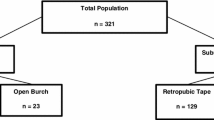Abstract
Only a few articles have reported clinical experience of treating patients with stress urinary incontinence following radical hysterectomy and postoperative irradiation. These cases are generally characterized by detrusor areflexia, small bladder capacity, and low bladder compliance. During the past 5 years, 13 such patients were operated upon, including 6 patients without irradiation. Of these 8 had the Stamey procedure, 3 had a vaginal wall sling, and 2 had a pubovaginal sling. The success rate was 71% for the group with irradiation and 100% for the group without irradiation, while the overall success rate was 85%. Surgery significantly improved two anatomic parameters in a chain cystourethrogram: the posterior urethrovesical angle and the conjugata incontinentia. Surgical indications relevant to successful outcome are discussed.
Similar content being viewed by others
References
McGuire EJ, Lytton B. Pubovaginal sling procedure for stress incontinence.J Urol 1978; 119:82–84
Woodside JR, Borden TA. Pubovaginal sling procedure for the management of urinary incontinence in a myelodysplastic girl.J Urol 1982; 127:744–746
Woodside JR. Suprapubic endscopic vesical neck suspension (Stamey procedure) for control of urinary incontinence in a woman following cauda equina injury.J Urol 1984; 132:940–942
Lawrence WT, Thomas DG. The Stamey bladder neck suspension operation for stress incontinence and neurovesical dysfunction.Br J Urol 1987; 59:305–310
Kato K, Kondo A, Takita T, et al. Incontinence in female neurogenic bladders. Resolution by endoscopic bladder neck suspension.Br J Urol 1987; 59:523–525
Thornton WN. Late urinary system complications following radical hysterectomy for carcinoma of the cervix.Am J Obstet Gynecol 1954; 67:867–882
Green TH, Meigs JV, Ulfelder H, et al. Urologic complications of radical Wertheim hysterectomy: incidence, etiology, management and prevention.Obstet Gynecol 1962; 20:293–312
Abrams P, Blaivas JG, Stanton SL, and Anderson JT. Standardisation of terminology of lower urinary tract function.Neurourol Urodynam 1988; 7:403–427
Kondo A, Kato K, Gotoh M, et al. Quantifying thread tension is of clinical use in Stamey bladder neck suspension: analysis of clinical parameters.J Urol 1989; 141:38–42
Raz S, Siegel AL, Short GL, et al. Vaginal wall sling.U Urol 1989; 141:43–46
McGuire EJ, Wang C, Usitalo H, et al. Modified pubovaginal sling in girls with myelodysplasia.J Urol 1986; 135:94–96
Fishman IJ, Shabsigh R, Kaplen AL. Lower urinary tract dysfunction after radical hysterectomy for carcinoma of cervix.Urology 1986; 28:462–468
Bostofte E, Serup J. Urological complicatins of Okabayashi's operation for cervical cancer.Acta Obstet Gynecol Scand 1981; 60:39–42
Author information
Authors and Affiliations
Additional information
Supported partly be a research grant for aging from the Japanese Ministry of Health and Welfare.
Editorial Comment: Little is known regarding the therapy of genuine stress incontinence following radical hysterectomy, especially when associated with radiation therapy. The surgeon is faced with potentially severely altered urethrovesical function due to the decentralization of the lower urinary tract secondary to the radical surgery. Non-compliant low capacity bladders make therapy of stress incontinence difficult. When radiation therapy is added marked alterations in tissue plasticity and blood supply result. The combination of all these factors complicate the medical and surgical therapy of incontience, and frequently the surgeon decides not to operate because of the increased possibility of failure. Although the numbers are small this paper demonstrates that good success rates for surgical therapy of genuine stress incontinence is possible when the proper surgical procedure is chosen.
Rights and permissions
About this article
Cite this article
Hasegawa, S., Kondo, A., Kato, K. et al. Stress urinary incontinence following radical hysterectomy with and without radiation therapy: Surgical results in 13 patients. Int Urogynecol J 2, 127–131 (1991). https://doi.org/10.1007/BF01997421
Issue Date:
DOI: https://doi.org/10.1007/BF01997421




